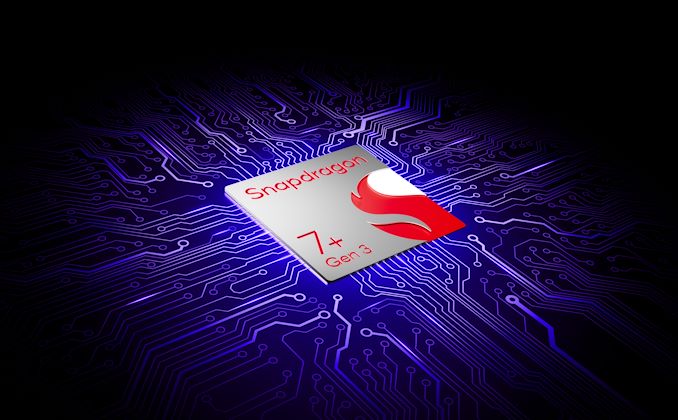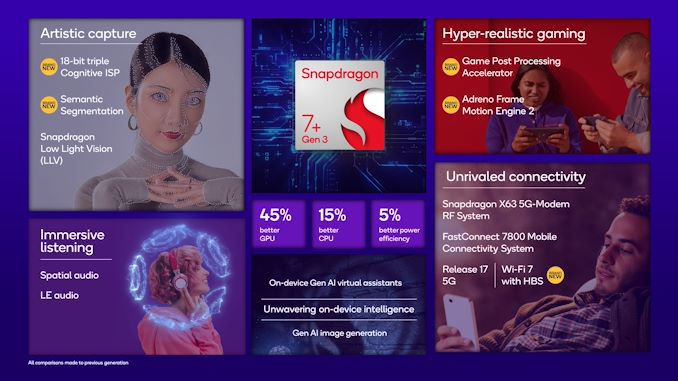
Original Link: https://www.anandtech.com/show/21316/qualcomm-intros-snapdragon-7-gen-3
Qualcomm Intros Snapdragon 7+ Gen 3: Pushing GenAI Into Premium Smartphones
by Ryan Smith on March 21, 2024 6:30 AM EST- Posted in
- Snapdragon
- Qualcomm
- Mobile
- SoCs
- Cortex-X4
- Snapdragon 7 Plus

Proving the adage “ask, and you shall receive”, Qualcomm is back this week for a second Snapdragon SoC announcement for mobile phones. This time, the company is announcing the Snapdragon 7+ Gen 3, the latest-generation member of their relatively new Snapdragon 7+ lineup of SoCs. Like its predecessor, the Snapdragon 7+ Gen 2, the Gen 3 is aimed at the premium segment of smartphones, offering high-end features with more modest performance and costs – but still a feature set and level of performance ahead of “mid-tier” smartphone SoCs. And, with Monday’s launch of the Snapdragon 8s Gen 3, this is a segment that has been bifurcated into two lines of SKUs over at Qualcomm.
With last year’s Snapdragon 7+ Gen 2 (7pG2) having established the template for the Snapdragon 7+ family, the Snapdragon 7+ Gen 3 (7pG3) has a much easier time defining its role in the world, and sliding into Qualcomm’s product stack. Despite the overarching Snapdragon 7 branding, the 7+ is still a distinctly more powerful chip than the mainline Snapdragon 7 family of chips (such as the vanilla Snapdragon 7 Gen 3), skirting the line between the two families. Most notably, the 7+ remains the lowest tier to get a high-performance Arm Cortex-X class CPU core as its prime CPU core, making a clear delineation between what chip families will and won’t offer flagship-grade single-threaded CPU performance.
| Qualcomm Snapdragon 7-Class SoCs | ||||
| SoC | Snapdragon 7+ Gen 3 (SM7675-AB) |
Snapdragon 7+ Gen 2 (SM7475-AB) |
Snapdragon 7 Gen 3 (SM7550-AB) |
|
| CPU | 1x Cortex-X4 @ 2.8GHz 4x Cortex-A720 @ 2.6GHz 3x Cortex-A520 @ 1.9GHz |
1x Cortex-X2 @ 2.91GHz 3x Cortex-A710 @ 2.49GHz 4x Cortex-A510 @ 1.8GHz |
1x Cortex-A715 @ 2.63GHz 3x Cortex-A715 @ 2.4GHz 4x Cortex-A510 @ 1.8GHz |
|
| GPU | Adreno | Adreno | Adreno | |
| DSP / NPU | Hexagon | Hexagon | Hexagon | |
| Memory Controller |
4x 16-bit CH @ 4200MHz LPDDR5X / 67.2GB/s |
2x 16-bit CH @ 3200MHz LPDDR5 / 25.6GB/s |
2x 16-bit CH @ 3200MHz LPDDR5 / 25.6GB/s |
|
| ISP/Camera | Triple 18-bit Spectra ISP 1x 200MP or 108MP with ZSL or 64+36MP with ZSL or 3x 32MP with ZSL 4K HDR video & 64MP burst capture |
Triple 18-bit Spectra ISP 1x 200MP or 108MP with ZSL or 64+36MP with ZSL or 3x 32MP with ZSL 4K HDR video & 64MP burst capture |
Triple 12-bit Spectra ISP 1x 200MP or 64MP with ZSL or 32+21MP with ZSL or 3x 21MP with ZSL 4K HDR video & 64MP burst capture |
|
| Encode/ Decode |
4K60 10-bit H.265 H.265, VP9 Decoding Dolby Vision, HDR10+, HDR10, HLG 1080p240 SlowMo |
4K60 10-bit H.265 H.265, VP9 Decoding Dolby Vision, HDR10+, HDR10, HLG 1080p240 SlowMo |
4K60 10-bit H.265 H.265, VP9 Decoding Dolby Vision, HDR10+, HDR10, HLG 1080p120 SlowMo |
|
| Integrated Radio | FastConnect 7800 Wi-Fi 7 + BT 5.4 2x2 MIMO |
FastConnect 6900 Wi-Fi 6E + BT 5.3 2x2 MIMO |
FastConnect 6700 Wi-Fi 6E + BT 5.3 2x2 MIMO |
|
| Integrated Modem | X63 Integrated 3GPP Rel 17 (5G NR Sub-6 + mmWave) DL = 4.2 Gbps UL = 3.5 Gbps 5G/4G Dual Active SIM (DSDA) |
X62 Integrated (5G NR Sub-6 + mmWave) DL = 4.4 Gbps 5G/4G Dual Active SIM (DSDA) |
X63 Integrated 3GPP Rel 17 (5G NR Sub-6 + mmWave) DL = 5.0 Gbps 5G/4G Dual Active SIM (DSDA) |
|
| Mfc. Process | TSMC 4nm | TSMC 4nm | TSMC 4nm | |
Diving into the specifications for the Snapdragon 7+ Gen 3, it looks suspiciously like a cut-down version of the Snapdragon 8s Gen 3 – something that's not too surprising given both the timing of the chip announcements, and the fact that the Snapdragon 7+ Gen 2 was a cut-down version of the Snapdragon 8+ Gen 1. Qualcomm will never confirm this level of die detail, of course, but the relatively high costs of producing masks for TSMC’s 4nm process means that Qualcomm is highly incentivized to use as few designs as possible to fill out the Snapdragon 7 and 8 series, which currently stands at 5 different SKUs (and seemingly, 4 different dies).
In any case, the 7pG3 retains its status as the cheapest Qualcomm SoC to include an Arm Cortex-X core. Clocked at 2.8GHz, it’s not pushing the same 3GHz+ clockspeeds of the Snapdragon 8 SoCs, but it still means that the 7pG3 comes with the most powerful CPU core Qualcomm offers on their mobile chips today. The rest of the cluster, meanwhile, is the same mix of Cortex-A720 performance cores and Cortex-A520 efficiency cores that we saw on the 8sG3, with a quartet of A720s clocked at 2.6GHz, and finally a trio of A520s clocked at 1.9GHz.
Qualcomm isn’t providing any CPU performance guidance on the 7pG3 versus the 8sG3 – preferring to focus on performance comparisons to the previous-generation Snapdragon 7 chips – but looking at clockspeeds on the otherwise identical CPU clusters, the 7pG3 should deliver around 90% of the 8sG3’s CPU performance. Otherwise, Qualcomm tells us that the 7pG3 should offer a modest 15% multi-threaded CPU performance boost over its “previous-generation” predecessor, which is being driven primarily by the architectural improvements in the CPU cores.
More notable, however, is the memory subsystem feeding the chip. Whereas the Snapdragon 7+ Gen 2 featured a 32-bit LPDDR5 memory bus – a typical size for Snapdragon 7 chips – the Snapdragon 7+ Gen 3 breaks that mold by including a 64-bit LPDDR5X memory bus – a configuration typically restricted to Snapdragon 8 chips. As a result, the 7pG3 has more than 2.5x the memory bandwidth available to it as the 7pG2, with a peak memory bandwidth of 67.2GB/second for the latest 7+ chip. The wider memory bus is doing most of the heavy lifting here, but the addition of LPDDR5X support is not to be overlooked; even with a max speed of LPDDR5X-8400, this represents a massive upgrade to the memory subsystem versus the 7pG2.
With so much extra memory bandwidth, it’s not surprising to see that Qualcomm is promising significant GPU performance gains with the 7pG3. All told, the company is touting the new chip as offering a 45% increase in GPU performance versus the Gen 2 chip. Typical for Qualcomm, we aren’t getting any more details on how the Adreno GPU is provisioned on the 7pG3, but Qualcomm would have needed to invest a fair bit more in terms of GPU transistors in order to improve GPU performance to this degree.
Unfortunately, the feature segmentation between the various Qualcomm SoCs remains a bit of a mess due to Qualcomm’s waterfall strategy. Whereas the 8 Gen 3 offers hardware ray tracing and global illumination support, and the 8s Gen 3 (still) offers ray tracing support, the 7+ Gen 3 discards the ray tracing support entirely. As a result, it’s still a relatively powerful GPU, but by flagship/premium smartphone standards, it is a decidedly last-generation GPU in terms of features. Though if nothing else, the version of the Adreno GPU IP does come with Qualcomm’s Adreno Frame Motion Engine 2.0 frame generation engine, which was first introduced on the Snapdragon 8 Gen 3.
Meanwhile, the DSP/NPU situation on the 7pG3 ends up looking a lot like the 8sG3: a mixed bag. Underscoring Qualcomm’s desire to push generative AI capabilities as far and wide into its SoCs as possible, the 7pG3 officially supports generative AI models, marking the first time this functionality has appeared in a 7+ SoC. However, Qualcomm’s spec sheets don’t show the generation of NPU IP used on the 7pG3 as being significantly different from the 7pG2, So as with the 8sG3, this appears to driven more by software enablement than it is hardware functionality.
Moving on, the 7pG3 retains Qualcomm’s triple 18-bit Spectra ISPs for its camera system, now using its newer-generation “cognitive” IP. In terms of raw features and resolution limits, things are unchanged from the previous generation – 4K60 video capture and photos up to 200MP – but the image processing capabilities have been improved under the hood. Most notably, this version of the Spectra ISP supports semantic segmentation for photo processing.
Video enthusiasts will be disheartened to see that AV1 decoding has not made it to this SKU, however. The 7pG3 can decode VP9 and H.265 video in hardware, but for the time being, AV1 hardware decoding remains exclusive to the Snapdragon 8 series. Presuming that the 7pG3 is in fact using the same die as the 8sG3, this implies that AV1 decoding is purposely being held back as a feature/cost differentiator.
Finally, the comms side of the 7pG3 is a sidegrade from the 7pG2. Classified as a Snapdragon X63 integrated modem, the 7pG3 supports both sub-6 and mmWave spectrums, with 2x2 MIMO on mmWave, and 4x4 MIMO on sub-6. The chip's max 5G upload speed is rated for 3.5Gbps, while the theoretical download speeds are actually a bit slower than the previous generation, at 4.2Gbps versus 4.4Gbps.
Paired with the X63 modem is Qualcomm’s FastConnect 7800 system, which offers Wi-Fi 7 support with 2x2 MIMO, as well as Bluetooth 5.4. This marks the first time that Wi-Fi 7 support has landed in a Snapdragon 7 SoC.
Wrapping things up, Qualcomm is positioning the Snapdragon 7+ Gen 3 as a straightforward successor to the Gen 2, offering a decent boost in CPU performance and a more significant boost in GPU performance, all with a 5% boost in energy efficiency. Compared to its predecessor, the latest 7+ SoC comes with a mix of new hardware and software features, but it’s also clearly been feature differentiated/restricted enough from the 8/8s to avoid stepping on the toes of the company’s best SoCs.
According to Qualcomm, phones based on the Snapdragon 7+ Gen 3 will be released in a few months. The first OEMs to adopt it will be SHARP, realme, and OnePlus. Though like its predecessor, we would be surprised to see the latest 7+ chip gain much traction outside of China.
Source: Qualcomm









